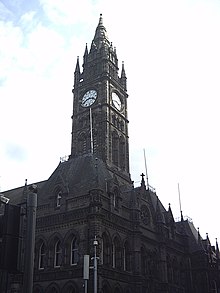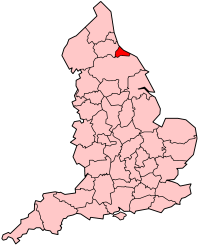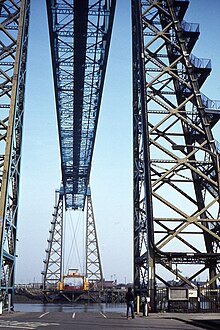| Cleveland | |
|---|---|
 Cleveland County Hall Cleveland County Hall | |
 Flag
Flag
 Coat of arms
Coat of arms
| |
 The former administrative county of Cleveland shown within England | |
| Area | |
| • 1974 | 144,085 acres (583.09 km) |
| Population | |
| • 1973 | 566,740 |
| • 1981 | 565,935 |
| • 1991 | 541,333 |
| History | |
| • Origin | County Borough of Teesside |
| • Created | 1974 |
| • Abolished | 1996 |
| ONS code | 14 |
| Government | Cleveland County Council |
| • Type | Two-tier - upper-tier county council with four lower-tier non-metropolitan borough councils |
| • HQ | Middlesbrough |
| Subdivisions | |
| • Type | Non-metropolitan districts |
| • Units | |
 | |
| Today part of | North Yorkshire and County Durham |
Cleveland was a non-metropolitan county located in North East England which existed between 1974 and 1996. Cleveland was a two-tier county and had four boroughs: Hartlepool, Stockton-on-Tees, Middlesbrough and Langbaurgh-on-Tees. The county town was Middlesbrough, where Cleveland County Council met. The county was named after the historic area of Cleveland, Yorkshire. Its area is now split between the counties of North Yorkshire and County Durham.
The county was abolished in 1996, with its constituent boroughs becoming unitary authorities. Hartlepool and the part of Stockton-on-Tees north of the River Tees became part of the County Durham, and the remainder became part of North Yorkshire. Some public bodies continue to cover the area of the former county, such as Cleveland Police and Cleveland Fire Brigade. Cleveland bordered County Durham to the north and North Yorkshire to the south, with a coastline on the North Sea to the east. It had a total area of 225 square miles (583 km).

Formation
A Bill as originally presented in November 1971 that intended the administrative county to have been an extended form of the then present County Borough of Teesside, an independent district in the North Riding from 1968 to 1974. On 1 April 1974, by the Local Government Act 1972, most of the then Cleveland constituency and Hartlepool were incorporated as the Cleveland non-metropolitan county.
Proposed abolition
Local government reorganisation, recommended by the Banham Review and accepted by the government, meant that each district borough be re-organised into separate unitary authorities with the Tees be re-established as a ceremonial border between North Yorkshire and County Durham. The county district boroughs of Cleveland were re-organised into Hartlepool, Stockton-on-Tees, Middlesbrough and Redcar and Cleveland. The reorganisation meant that Stockton-on-Tees became the only local authority in England to be split between two counties.
This split was contested by Cleveland County Council, who applied for judicial review over the decision. According to the Minister, David Curry, in the Commons debate on the order on 11 January 1995, this caused a delay from 1 April 1995 as the reorganisation date to 1 April 1996.
Abolition
The Cleveland (Structural Change) Order 1995 abolished the County Council (to take place on 1 April 1996) and transferred its powers to the district councils, though it did not abolish Cleveland itself. It also renamed Langbaurgh-on-Tees as Redcar and Cleveland.
The Cleveland (Further Provision) Order 1995 abolished the county of Cleveland altogether, also from 1 April 1996, creating in its place four counties corresponding to the four boroughs. However, the requirement for counties to have a council was removed for these four counties in particular. Further regulations placed each district within the ceremonial county of Durham or North Yorkshire, also splitting Stockton-on-Tees along the Tees.
Town twinning
See also: List of twin towns and sister cities in the United KingdomCleveland, as a conurbation of settlements, was twinned with:
 Cleveland, Ohio, United States
Cleveland, Ohio, United States
Statistical
NUTS statistical regions of the United Kingdom were also introduced in 1974. This caused South Humberside to be put with the reformed counties using the name Yorkshire, to form Yorkshire and Humber. South Tees came under North East of England region.
Demographics
Main article: Demographics of Tees ValleySee also
References
- Local government in England and Wales: A Guide to the New System. London: HMSO. 1974. p. 37. ISBN 0-11-750847-0.
- Registrar General's annual estimated figure mid 1973
- Michael Bates, MP for Langbaurgh (17 June 1993). "Cleveland County Council (Abolition)". Parliamentary Debates (Hansard). United Kingdom: House of Commons. col. 1089–1098.
- "Teesside: Town and country welcome Whitehall compromise". The Times. London: Thomson Corporation. 21 March 1972.
- ^ "The Cleveland (Further Provision) Order 1995", legislation.gov.uk, The National Archives, 10 July 1995, SI 1995/1747, retrieved 13 July 2021
- "The Cleveland (Structural Change) Order 1995", legislation.gov.uk, The National Archives, 30 January 1995, SI 1995/187, retrieved 13 July 2021
- Lieutenancies Act 1997 1997 c.23
- "The Local Government Changes for England (Miscellaneous Provision) Regulations 1995", legislation.gov.uk, The National Archives, SI 1995/1748, retrieved 6 March 2024
- "Interactive City Directory". Sister Cities International. Archived from the original on 5 October 2019. Retrieved 5 October 2019.
- Great Britain Historical GIS / University of Portsmouth, Teesside County Borough (historic map). Retrieved 17 September 2009.
External links
| County Durham |  | |
|---|---|---|
| Northumberland | ||
| Tyne and Wear | ||
| Teesside, North Yorkshire | ||
54°33′58″N 1°09′47″W / 54.566°N 1.163°W / 54.566; -1.163
Categories: